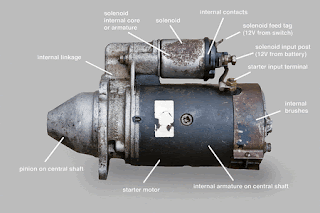Inertia type:
Inertia starters incorporate low weight in proportion to the torque capacity of the starter. a perk of using inertia starter is their low current drag on the electrical system. the pinion gear is forced forward to mesh with the flywheel from the spinning of the armature. torque overload consists of a disk clutch under adjustable spring pressure.
Pre engage:
Pre engaged starters prevent an awful lot of wear on the ring gear and Bendix gear. They were a big jump forwards in reliability. Non preengaged starters work by throwing a spinning cog at the ring gear on the flywheel to turn the engine. It will only disengage when the engine reaches sufficient speed to throw the cog out again, or the igntion key is turned back from 'start'. A lot of wear as you can imagine. Pre engaged have the cog already in place on the ring gear before the starter motor turns. Once the ignition key is turned back to 'Ign' it disengages and waits until the ignition is turned off before re engaging with the ring gear.
Pre engaged starters prevent an awful lot of wear on the ring gear and Bendix gear. They were a big jump forwards in reliability. Non preengaged starters work by throwing a spinning cog at the ring gear on the flywheel to turn the engine. It will only disengage when the engine reaches sufficient speed to throw the cog out again, or the igntion key is turned back from 'start'. A lot of wear as you can imagine. Pre engaged have the cog already in place on the ring gear before the starter motor turns. Once the ignition key is turned back to 'Ign' it disengages and waits until the ignition is turned off before re engaging with the ring gear.
Reduction gear
The operator closed the key-operated starting switch.A small electric current flowed through the starter relay coil, closing the contacts and sending a large current to the starter motor assembly.One of the pole shoes, hinged at the front, linked to the starter drive, and spring-loaded away from its normal operating position, swung into position. This moved a pinion gear to engage the flywheel ring gear, and simultaneously closed a pair of heavy-duty contacts supplying current to the starter motor winding.The starter motor cranked the engine until it started. An overrunning clutch in the pinion gear uncoupled the gear from the ring gear.The operator released the key-operated starting switch, cutting power to the starter motor assembly.A spring retracted the pole shoe, and with it, the pinion gear.
Alternator:
This is found usually at the front of the engine This works with the battery and the engine.
The alternator chargres the battery and the engine drives the alternator. This is what provides power for all the electricals while your car is running. It is driven by a crank shaft and belt.
your car would not run with out one of these as the battery can not power the car and would simply go dead if the alternator died. The name alternator come for alternating current( AC ).
Generator:
a generator is basicaly the same.
Alternators generate electricity by the same principle as DC generators, namely, when the magnetic field around a conductor changes, a current is induced in the conductor. Typically, a rotating magnet called the rotor turns within a stationary set of conductors wound in coils on an iron core, called the stator. The field cuts across the conductors, generating an electrical current, as the mechanical input causes the rotor to turn.
The operator closed the key-operated starting switch.A small electric current flowed through the starter relay coil, closing the contacts and sending a large current to the starter motor assembly.One of the pole shoes, hinged at the front, linked to the starter drive, and spring-loaded away from its normal operating position, swung into position. This moved a pinion gear to engage the flywheel ring gear, and simultaneously closed a pair of heavy-duty contacts supplying current to the starter motor winding.The starter motor cranked the engine until it started. An overrunning clutch in the pinion gear uncoupled the gear from the ring gear.The operator released the key-operated starting switch, cutting power to the starter motor assembly.A spring retracted the pole shoe, and with it, the pinion gear.
Alternator:
This is found usually at the front of the engine This works with the battery and the engine.
The alternator chargres the battery and the engine drives the alternator. This is what provides power for all the electricals while your car is running. It is driven by a crank shaft and belt.
your car would not run with out one of these as the battery can not power the car and would simply go dead if the alternator died. The name alternator come for alternating current( AC ).
Generator:
a generator is basicaly the same.
Alternators generate electricity by the same principle as DC generators, namely, when the magnetic field around a conductor changes, a current is induced in the conductor. Typically, a rotating magnet called the rotor turns within a stationary set of conductors wound in coils on an iron core, called the stator. The field cuts across the conductors, generating an electrical current, as the mechanical input causes the rotor to turn.



Good explanations, except not in depth enough regarding the reduction starter.
ReplyDelete